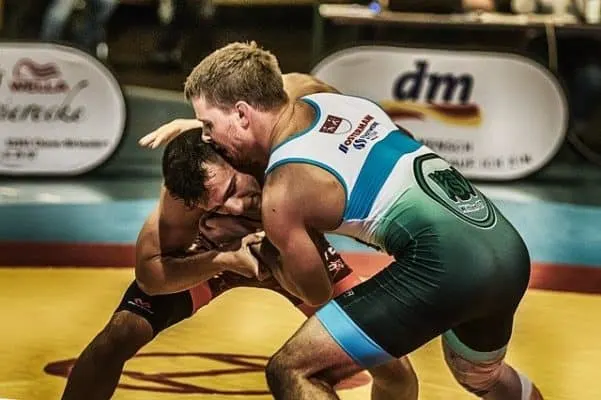
Mixed martial arts (MMA) is famous for combining a wide variety of fighting styles from all over the world. Despite this, when it comes to finding success inside the ring, statistics tend to skew in favor of wrestling compared to all the rest. I did some research on why this is the case, and have discovered many reasons to explain wrestling’s dominance in MMA.
According to famous MMA color commentator Joe Rogan, wrestlers dominate MMA because the wrestling style allows fighters to “dictate where the fight takes place”. Wrestlers tend to have an easier time putting their opponent into a disadvantageous position and are also equipped with the tools needed to keep them there.
But this isn’t the only reason as to why wrestlers continue to see great success in professional MMA. There are also a host of other factors at play that combine to give wrestling the edge over other popular fighting styles.
Why Is Wrestling So Effective In MMA?
According to research by Sebastian Rivera, a two-time All-American for Northwestern, between the years 1997 and 2018, wrestling has produced a total of 27 UFC champions, more than any other major fighting style and beating the second most dominant fighting style, Brazilian Jiu-Jitsu (BJJ) by a hefty 10 champions.
One reason for wrestling’s dominant position in MMA is because the wrestling style which favors controlling the opposition also translates well into the competitive MMA environment. A study by the UFC Performance Institute claimed the following:
“…controlling an opponent, be it on the feet or ground fighting, is of significance and also has a high effect on the probability of winning a fight”.
From UFC
This might be due to the way fights are scored in the UFC. In the official unified guidelines, judges are expected to evaluate fights based on three prioritized criteria: Effective Striking/Grappling, Effective Aggressiveness, and Fighting Area Control.
Top-tier wrestlers that manage to take down their opponent can prevent counterattacks or attempt to gain points by suppressing their opponent’s ability to strike back.
In other words, they can limit their opponents’ opportunities to score via both Effective Striking/Grappling and Effective Aggressiveness. At the same time, they also can gain points for Fighting Area Control, as they are the ones who are dictating the pace, place, and position of the match. Without a way for the opponent to win back points, most wrestlers are able to win rounds simply by staying on top of their opponent and not doing anything else.
If we also take into consideration the visual aspect and how that might play into the way judges score fights, then a downed and suppressed fighter is always going to look worse off regardless of what official guidelines state. It is important to keep in mind that while many rules are in place to guide the decisions of the judges, inevitably, the final call is based on each individual’s subjective feelings on what they see.
The takedown itself is also another area where judge bias may come into play. Takedowns tend to be heavily weighted on the judges’ scorecards. Which can make the fight tailored specifically for wrestling, a style that prioritizes takedowns as a way of controlling the opposition.
One fighter that dominates much of a single round can often see the table completely turned if an experienced wrestler manages to score a takedown in the closing seconds. Conversely, if the wrestler managers to take down his opponent in the early stages, he can simply focus all his energy on keeping the opponent pinned and still be winning on the judges’ scorecards despite not being able to use the takedown for any offensive actions.
Does Wrestling Intensity Have Dominance over MMA?
One factor we should consider is the vast number of wrestlers being trained over time compared to other styles in MMA as well as the intensity of the training wrestlers tend to undergo.
As a famous Olympic sport with a rich history that stretches as far back as 776 BCE, wrestling continues to see greater participation than many of the other fighting styles that make up the MMA industry. Wrestling is often associated with extensive high school and college programs, and even partial scholarships that can provide great opportunities for hopeful athletes.
The average wrestler tends to begin training at a very young age, with Bill Campbell, wrestling coach for Northfield Athletics, stating in a guide that kids can begin as young as age 4 or 5. And the intensity and duration of training tends to be higher than other dominant fighting styles. Wrestlers tend to see the sport as more than a hobby.
High numbers of pro-wrestling tournaments and the impact of global organizations like the WWE should also be taken into account. Due to the intensity of training and competitive atmosphere surrounding the wrestling industry, many professional wrestlers that transition to MMA are usually already well-equipped to deal with performing on stage in front of an audience. Many of them are also likely to have many matches on their records.
Because of this, the quality of wrestling athletes transitioning to MMA may be on another level compared to other dominating fighting styles. Research by college wrestling coach Mike R. into the statistical relationship between wrestling pedigree and MMA success also concluded that there is likely a correlation between amateur wrestling success and MMA success.
At the time this study was conducted back in 2012, there were still many promising wrestling Olympian athletes outside MMA ready to make a transition over to should the opportunity arise. If a proportion of these athletes did indeed choose to move over to MMA, then that may be one of the reasons explain wrestling’s continued dominance.
Other styles that contribute to MMA tend to not see the same level of participation at the highest level. The second most dominant style, Brazilian Jiu-Jitsu, is not an Olympic sport, and despite growing popularity, still pales in comparison to wrestling in terms of the sheer number of participants.
RECOMMENDED FOR YOU: Freestyle Wrestling vs. Greco Roman: Key Differences and Comparison
Will Wrestling Continue To Dominate MMA?
An article by Andrew Barr puts forward the theory that wrestling’s dominance in MMA is but a temporary spike and will eventually subside as more and more new fighters continue entering this field.
According to Andrew, wrestling superiority in MMA is mainly because fighters who come into MMA only do so after training in their sport of choice for a long time. In other words, many of the current MMA fighters have to adapt their knowledge and skillset from their previous discipline into MMA, rather than training in MMA from the start.

Because wrestling translates better into MMA compared to all the other popular styles, it should come as no surprise that fighters with a wrestling background continue to dominate within the ring. For example, fighters with a background in a style that favors striking can find it difficult to defend from the wrestling takedown.
However, as the sport continues to develop and grow in popularity, we may begin to see the next generation of fighters start training MMA early on with the goal of eventually becoming a professional MMA fighter, rather than starting with another discipline and transitioning to MMA.
If so, then this new breed of fighters will likely have been training in a wide variety of styles which may level the playing field by making them less susceptible to techniques like wrestling takedowns.
Others argue that wrestling will continue to play a dominant role in MMA simply because it is a better base for the sport compared to other fighting styles like Brazilian Jiu-Jitsu and can help future MMA fighters forge the sort of athleticism that will be of great use regardless of what style they choose to focus on later on in their career.
